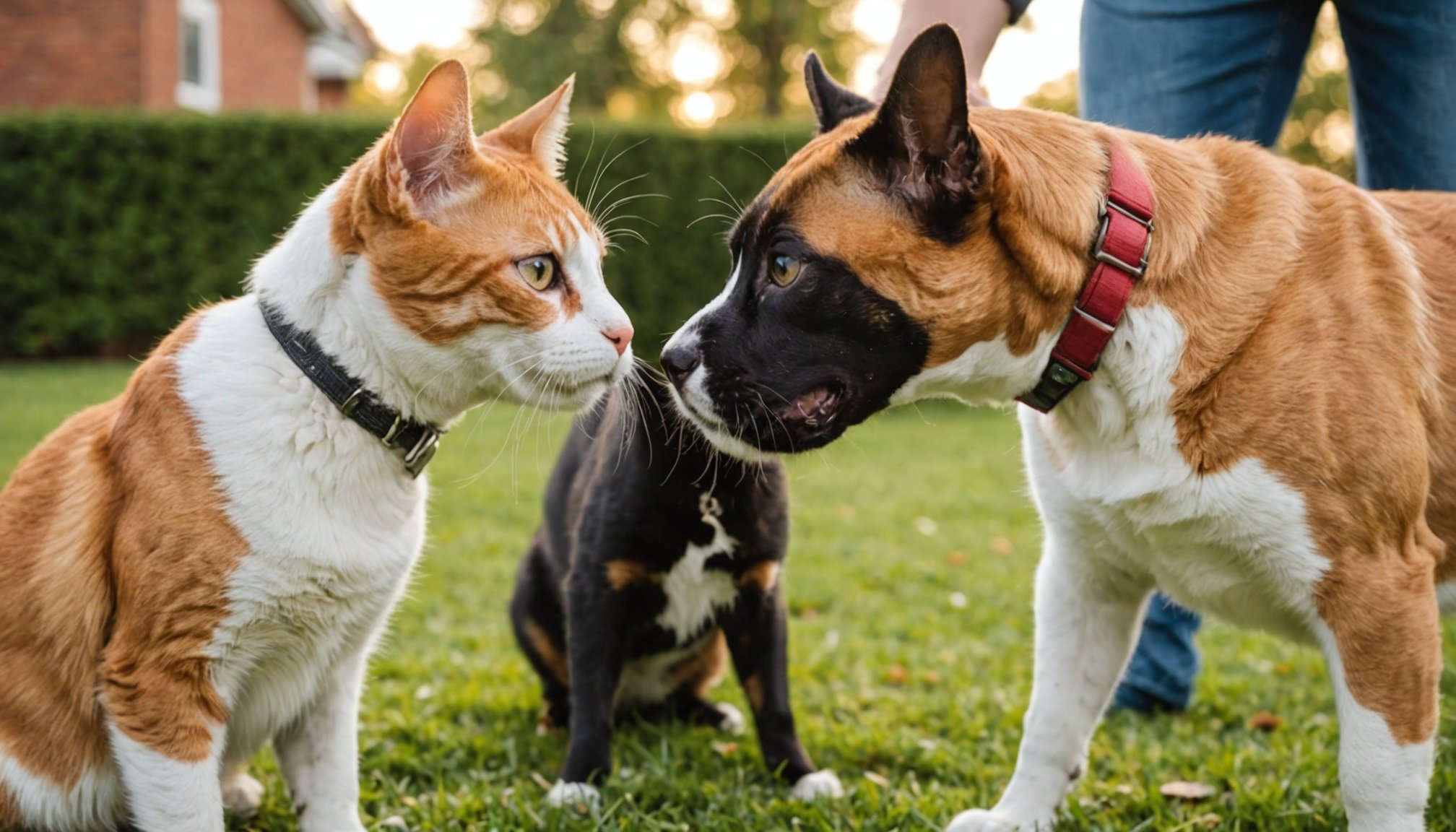Understanding Cat-Dog Dynamics
The relationship between cats and dogs has intrigued pet owners and experts for generations. To foster animal compatibility, it is essential to delve into their natural instincts. Dogs often exhibit pack behaviors, inclined to establish hierarchies, while cats tend to be territorial and independent.
Both species demonstrate distinct cat-dog behavior traits. Dogs might be more social, eager to please, and energetic. In contrast, cats can show a calm demeanor and display curiosity with caution. Recognising these tendencies helps in anticipating their interactions and planning introductions.
This might interest you : What are the best practices for grooming your long-haired cat?
Key factors influencing cat-dog behavior involve past experiences, the environment, and the individual personalities of the animals. For instance, a dog accustomed to living with other animals might behave more calmly in the presence of a new cat. Similarly, a cat that has never encountered a dog might feel anxious.
Understanding these dynamics is crucial for achieving harmony between these species. A successful introduction takes time, patience, and acknowledgment of each animal’s needs and instincts. This information lays the groundwork for building a positive relationship between a cat and a dog in the same household.
In the same genre : What are the best ways to introduce a new pet hamster to your existing pets?
Preparing for the Introduction
Ensuring a harmonious introduction between a cat and a dog requires careful planning and environment preparation. Following a structured approach can set the foundation for a successful relationship.
Creating safe spaces is paramount to promoting animal compatibility. Such designated areas allow each pet to retreat and feel secure during the initial interactions. Cats typically benefit from elevated spaces or enclosed rooms, providing them with a vantage point to observe without feeling threatened. For dogs, allocating a personal space with their bed or crate can create a stress-free zone.
Gradual exposure techniques play a critical role in the introduction strategies. Start by allowing the animals to explore each other’s scent through scent swapping. This can be achieved by exchanging bedding or toys, familiarizing them with each other’s presence indirectly. Once both are comfortable with the scents, introduce visual contact by using a barrier, such as a baby gate, to prevent direct interaction but enabling them to see each other.
Remember, patience is key. Progress at a pace suitable for both pets and be attentive to any signs of stress or discomfort. By doing so, you facilitate an environment where trust and mutual respect can develop naturally.
Step-by-Step Introduction Process
Ensuring a smooth introduction process between your cat and dog is key to their mutual comfort and happiness.
Initial Meetings
Start these encounters in a neutral space. The idea here is to avoid overwhelming your pets. Keep the interaction techniques gentle and rewarding. Begin by having both animals on a leash or held securely. Observe their body language closely. If either displays signs of distress—such as growling, hissing, or hiding—ideally, stop the interaction and give them some space.
Supervised Interactions
Gradually progress to more interactive sessions with supervision. Use positive reinforcement like treats and praise to encourage calm behaviour. Allow brief exchanges and gradually extend the time based on their growing comfort. Always keep a close eye on their body language for any signs of stress or unease.
Gradual Freedom
Once your pets show more relaxed behaviours, you can start allowing short periods off-leash under supervision. This stage in the interaction process helps them grow accustomed to sharing their space more freely. Monitor their interactions and progressively increase the freedom, always prepared to step back if tensions rise.
Monitoring Behavior and Adjusting Techniques
Constantly observing your pets during the introduction phase is crucial to maintain harmony. Understanding their behavior assessment is essential in discerning discomfort signals. Recognizing early signs of stress or aggression, such as growling, excessive hiding, or prolonged hissing, enables proactive intervention before tensions escalate.
When you observe adverse reactions, implementing effective adjustment strategies can mitigate potential conflicts. For instance, temporarily returning to a previous stage in the process can help reacquaint the pets in a less stressful manner. This step backward gives each animal time to adjust at its own pace, fostering a positive atmosphere.
Reassessment becomes necessary if initial techniques prove ineffective. Reviewing the introduction plan and making small alterations might be the key to success. Consider the environments, as small changes in routine or location can greatly impact comfort levels. Tailoring these introduction techniques to address the unique needs of each pet supports gradual acclimatization.
Remember, patience and flexibility are vital. By keeping an attentive eye and being ready to adapt, you significantly improve the chances of a peaceful, long-term coexistence. This careful monitoring nurtures a foundation of trust and mutual respect between your cat and dog.
Common Pitfalls to Avoid
Ensuring a successful bond between cats and dogs requires avoiding common introduction mistakes. One frequent oversight is overestimating their readiness to interact. Rushing the process might escalate hostilities, so ensure both pets feel calm before each meeting. Challenges in pet integration often stem from neglecting the unique personalities of each animal. Cats might take longer to warm up, while dogs could become overly enthusiastic. Recognise these differences to personalise the approach.
Maintaining safety during initial meetings is crucial to prevent stress. Forgetting to establish secure spaces for each pet often leads to anxiety. Safe zones are sanctuaries, allowing retreats when interactions become too intense. Failing to monitor body language might result in missing warning signs of aggression or fear. It’s vital to observe their behaviours closely to gauge comfort levels.
Another typical misstep includes inconsistent routines. Animals thrive on stability, and drastic changes can unsettle them. Keep feeding and activity schedules regular, promoting familiarity amidst the new dynamics. By understanding and overcoming these challenges in pet integration, you increase the likelihood of fostering a harmonious relationship between your cat and dog.
Real-Life Case Studies
Understanding real-life case studies can shed light on the complexities of cat-dog introductions. These practical examples provide insights into successful success stories and how different strategies can be tailored to fit unique scenarios.
One notable case involved a family successfully introducing a kitten into a household with a senior dog. The key was a slow, deliberate approach, incorporating gradual exposure and scent swapping over weeks. They prioritized creating safe spaces—a room for the cat and a bed for the dog—allowing both pets to retreat when feeling overwhelmed. This approach resulted in a positive bond built on mutual respect.
Conversely, lessons learned from failed introductions can be equally informative. A hurried approach with limited supervision led to tension and negative interactions between another set of pets. This misstep highlighted the importance of pacing introductions and monitoring body language for stress signals.
Pet owners offer invaluable tips from pet owners: patience, consistency, and awareness of each animal’s needs are crucial for success. Many recommend maintaining separate feeding and relaxation areas to prevent resource guarding. Such experiences serve as practical guides, encouraging an adaptive approach catering to the individual dynamics of each home.
Conclusion and Additional Resources
Achieving harmony between cats and dogs requires attentive strategy and practice. Key to success is understanding animal compatibility and recognizing individual personalities. For additional support, consider these resources for further reading:
- Expert-written pet care books offer step-by-step guides on mixed-species households.
- Online forums and communities provide insights, anecdotes, and peer recommendations.
Leverage knowledge from expert advice to enrich your strategy. Renowned animal behaviourists often share practical tips through webinars and articles, enhancing your learning journey.
In-depth case studies illuminate diverse scenarios. Reviewing them can unveil new perspectives, guiding your specific introduction process. Opt for multimedia resources like instructional videos to visualise effective introduction techniques.
Engage actively in community support networks. Connecting with fellow pet owners fosters encouragement, sharing experiences, setbacks, and triumphs alike. Attend local workshops where hands-on guidance from seasoned trainers could be available.
It’s vital to explore continually and adapt—personalising across contexts and circumstances. Refresh your knowledge and techniques, fostering continual improvement in nurturing a peaceful multi-pet household.










